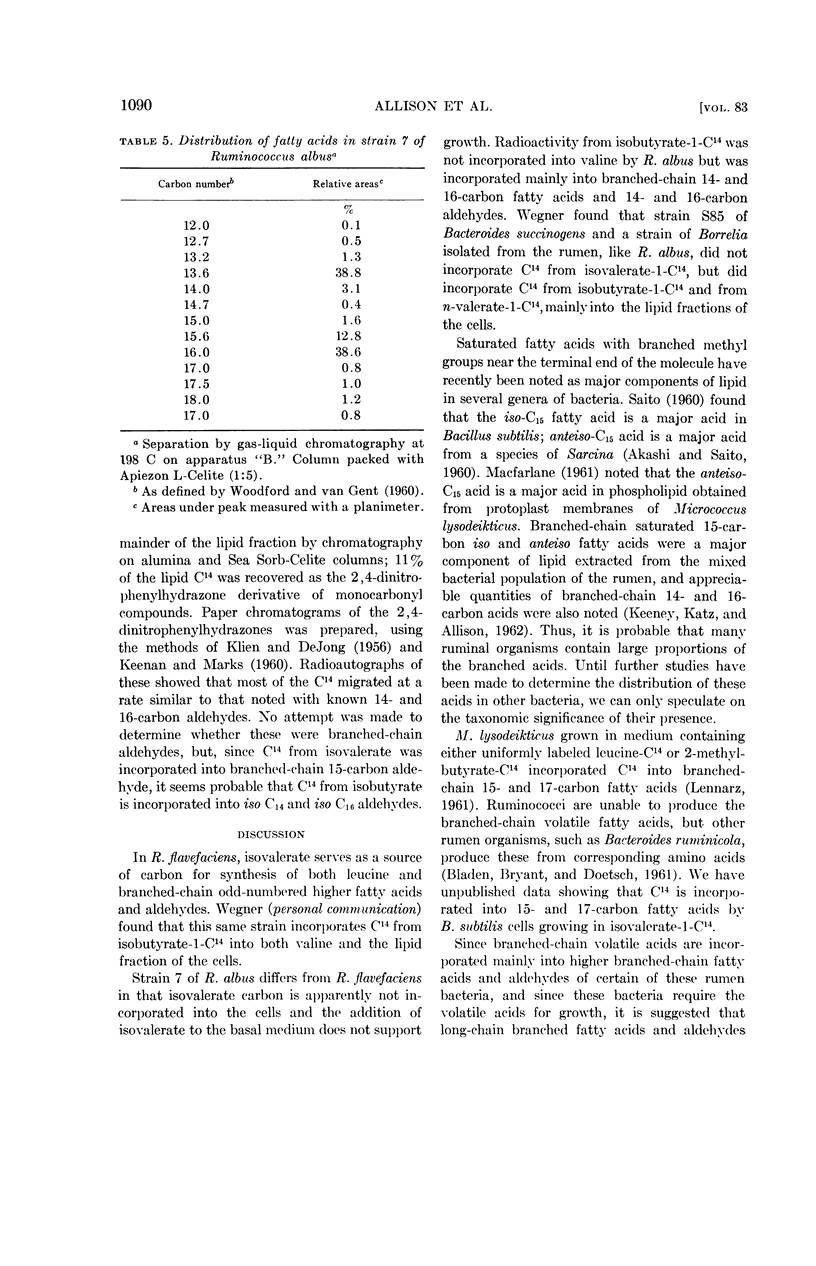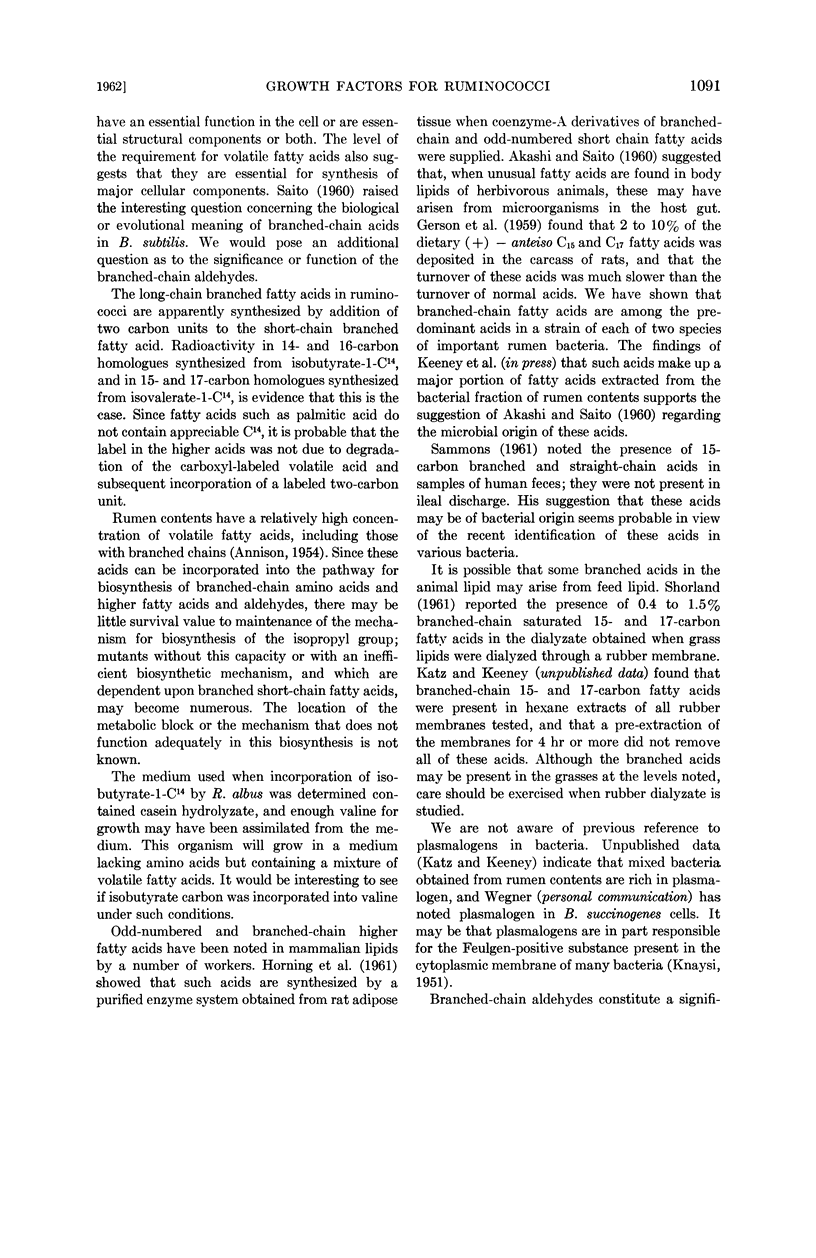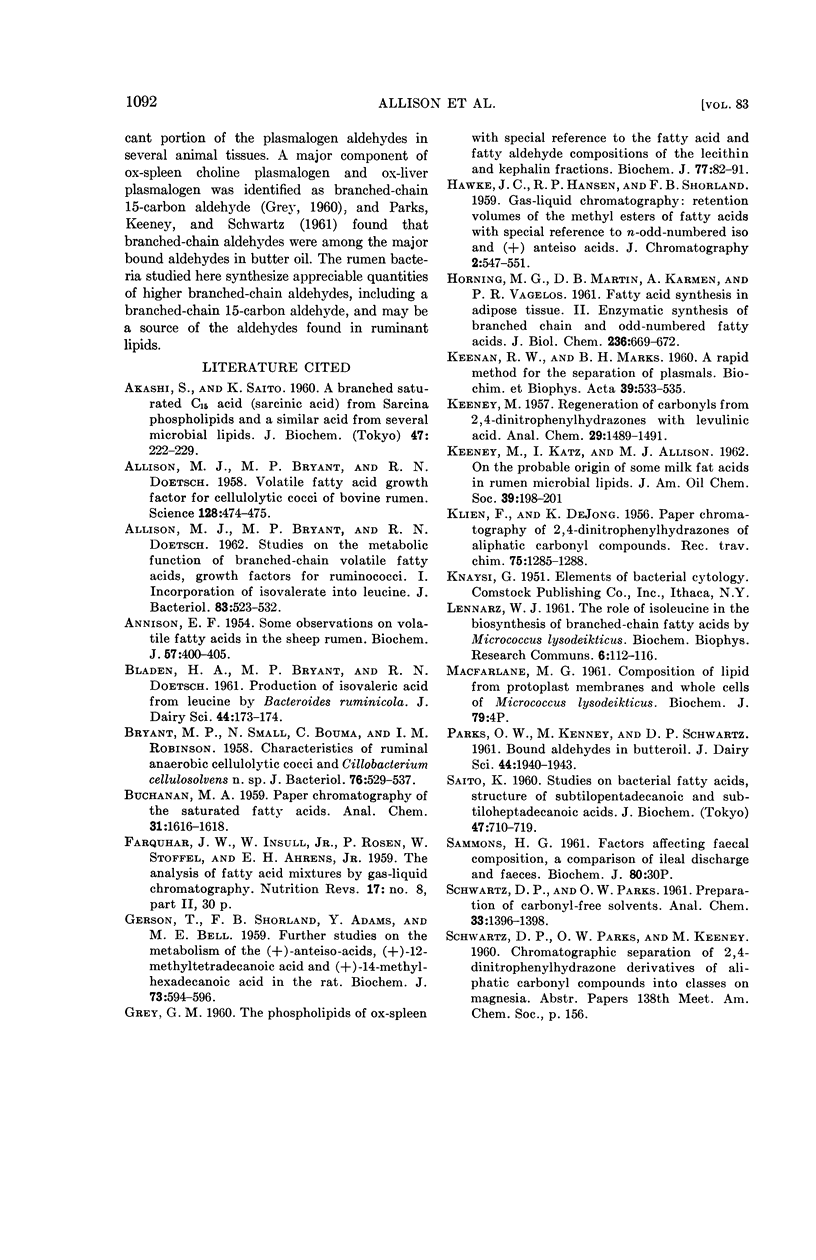Abstract
Allison, M. J. (Dairy Cattle Research Branch, USDA, Beltsville, Md.), M. P. Bryant, I. Katz, and M. Keeney. Metabolic function of branched-chain volatile fatty acids, growth factors for ruminococci. II. Biosynthesis of higher branched-chain fatty acids and aldehydes. J. Bacteriol. 83:1084–1093. 1962.—A number of strains of rumen bacteria require branched-chain volatile fatty acids for growth. A strain of Ruminococcus flavefaciens that requires either isovalerate or isobutyrate incorporates radioactive carbon from isovalerate-1-C14 and isovalerate-3-C14 into leucine and into the lipid fraction of the cells. Evidence obtained by both paper and gas chromatography indicated that most of the label in the lipid of cells grown in isovalerate-1-C14 was in a branched-chain 15-carbon fatty acid, with some in a 17-carbon acid; about 7.5% of the C14 was recovered in a branched-chain 15-carbon aldehyde. The aldehydes were in the phospholipid fraction and were presumably present as plasmalogen.
A strain of R. albus was shown to require isobutyrate, 2-methyl-n-butyrate, or 2-ketoisovalerate for growth. This strain did not incorporate appreciable C14 from isovalerate-1-C14 or isovalerate-3-C14. When grown in a medium containing isobutyrate-1-C14, most of the cellular C14 was found in the lipid fraction. Analysis of the lipid demonstrated that the label was present mainly as branched-chain 14-carbon and 16-carbon fatty acids, with 11% of the C14 present in 14- and 16-carbon carbonyl compounds, presumably branched-chain aldehydes.
Branched-chain 14-, 15-, and 16-carbon fatty acids are major components of the lipids of these rumen bacteria. The possibility that these acids and aldehydes, which are found in ruminant body and milk lipids, may be of microbial origin is discussed.
Full text
PDF









Selected References
These references are in PubMed. This may not be the complete list of references from this article.
- ALLISON M. J., BRYANT M. P., DOETSCH R. N. Studies on the metabolic function of branched-chain volatile fatty acids, growth factors for ruminococci. I. Incorporation of isovalerate into leucine. J Bacteriol. 1962 Mar;83:523–532. doi: 10.1128/jb.83.3.523-532.1962. [DOI] [PMC free article] [PubMed] [Google Scholar]
- ALLISON M. J., BRYANT M. P., DOETSCH R. N. Volatile fatty acid growth factor for cellulolytic cocci of bovine rumen. Science. 1958 Aug 29;128(3322):474–475. doi: 10.1126/science.128.3322.474. [DOI] [PubMed] [Google Scholar]
- ANNISON E. F. Some observations on volatile fatty acids in the sheep's rumen. Biochem J. 1954 Jul;57(3):400–405. doi: 10.1042/bj0570400. [DOI] [PMC free article] [PubMed] [Google Scholar]
- BRYANT M. P., SMALL N., BOUMA C., ROBINSON I. M. Characteristics of ruminal anaerobic celluloytic cocci and Cillobacterium cellulosolvens n. sp. J Bacteriol. 1958 Nov;76(5):529–537. doi: 10.1128/jb.76.5.529-537.1958. [DOI] [PMC free article] [PubMed] [Google Scholar]
- GERSON T., SHORLAND F. B., ADAMS Y., BELL M. E. Further studies on the metabolism of the (plus)-anteiso-acids, (plus)-12-methyltetradecanoic acid and (plus)-14-methyl-hexadecanoic acid, in the rat. Biochem J. 1959 Dec;73:594–596. doi: 10.1042/bj0730594. [DOI] [PMC free article] [PubMed] [Google Scholar]
- GRAY G. M. The phospholipids of ox spleen with special reference to the fatty acid and fatty aldehyde compositions of the lecithin and kephalin fractions. Biochem J. 1960 Oct;77:82–91. doi: 10.1042/bj0770082. [DOI] [PMC free article] [PubMed] [Google Scholar]
- HORNING M. G., MARTIN D. B., KARMEN A., VAGELOS P. R. Fatty acid synthesis in adipose tissue. II. Enzymatic synthesis of branched chain and odd-numbered fatty acids. J Biol Chem. 1961 Mar;236:669–672. [PubMed] [Google Scholar]
- KEENAN R. W., MARKS B. H. A rapid method for the separation of plasmals. Biochim Biophys Acta. 1960 Apr 22;39:533–535. doi: 10.1016/0006-3002(60)90209-2. [DOI] [PubMed] [Google Scholar]
- LENNARZ W. J. The role of isoleucine in the biosynthesis of branched-chain fatty acids by Micrococcus lysodeikticus. Biochem Biophys Res Commun. 1961 Nov 1;6:112–116. doi: 10.1016/0006-291x(61)90395-3. [DOI] [PubMed] [Google Scholar]
- STRASSMAN M., SHATTON J. B., WEINHOUSE S. Conversion of alpha-acetolactic acid to the valine precursor, alpha,beta-dihydroxyisovaleric acid. J Biol Chem. 1960 Mar;235:700–705. [PubMed] [Google Scholar]


